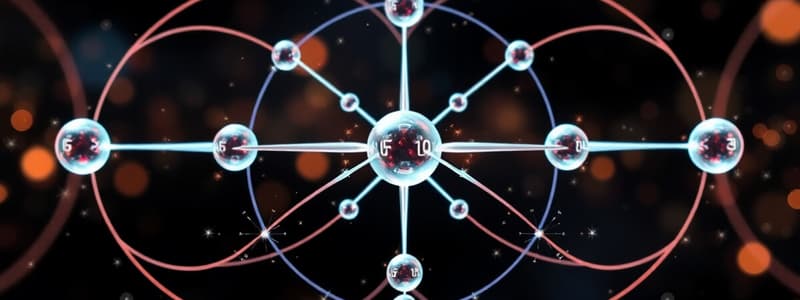Podcast
Questions and Answers
Fock's theory is fundamental to which atomic element?
Fock's theory is fundamental to which atomic element?
- Lithium
- Hydrogen (correct)
- Beryllium
- Helium
Fock's theory allows realization of the rotation group of a 3D sphere in what space?
Fock's theory allows realization of the rotation group of a 3D sphere in what space?
- Three-dimensional space
- Four-dimensional space (correct)
- Five-dimensional space
- Two-dimensional space
What type of space is used to simplify the Schrödinger equation in the modified Fock's theory?
What type of space is used to simplify the Schrödinger equation in the modified Fock's theory?
- Five-dimensional space
- Four-dimensional space (correct)
- Two-dimensional space
- Three-dimensional space
In modifying Fock's theory, invariant tensor methods of electrostatics are used in which spaces?
In modifying Fock's theory, invariant tensor methods of electrostatics are used in which spaces?
In the modified Fock's theory, which equation does the Schrödinger equation become in a 4D coordinate space?
In the modified Fock's theory, which equation does the Schrödinger equation become in a 4D coordinate space?
In the modified Fock's theory, the transition from harmonic 4D polynomials to the original 3D physical space involves derivatives with respect to which entity?
In the modified Fock's theory, the transition from harmonic 4D polynomials to the original 3D physical space involves derivatives with respect to which entity?
The Schwinger resolvent can be derived by what method?
The Schwinger resolvent can be derived by what method?
What is the quantum Coulomb problem fundamental for calculating?
What is the quantum Coulomb problem fundamental for calculating?
The group SO(4) of rotations in four dimensional space represents an underlying symmetry of what?
The group SO(4) of rotations in four dimensional space represents an underlying symmetry of what?
In quantum mechanics, what do the classical vector integrals correspond to?
In quantum mechanics, what do the classical vector integrals correspond to?
The transformation of variables and operators maps the original quantum Coulomb problem into another problem, what is it?
The transformation of variables and operators maps the original quantum Coulomb problem into another problem, what is it?
In Fock's approach, what is the starting point in his theory?
In Fock's approach, what is the starting point in his theory?
What is applied in this paper to eigenfunctions extended harmonically to the 4D momentum space?
What is applied in this paper to eigenfunctions extended harmonically to the 4D momentum space?
What are the eigenfunctions when transitioning to the 4D coordinate space in the modified Fock's theory?
What are the eigenfunctions when transitioning to the 4D coordinate space in the modified Fock's theory?
The advantage of using tensors in the perturbation theory is demonstrated in calculating which effect?
The advantage of using tensors in the perturbation theory is demonstrated in calculating which effect?
To modify the Fock theory, what is convenient to use in moving to the 4D coordinate space?
To modify the Fock theory, what is convenient to use in moving to the 4D coordinate space?
When harmonic tensors are used, what coordinate is singled out in the physical space?
When harmonic tensors are used, what coordinate is singled out in the physical space?
What gets multiplied by the imaginary unit i and equated to the length of the radius vector |r|?
What gets multiplied by the imaginary unit i and equated to the length of the radius vector |r|?
What remains unchanged under transformations when using harmonic tensors?
What remains unchanged under transformations when using harmonic tensors?
The extension from the Fock sphere into 4D space is linked to the use of what mathematical objects?
The extension from the Fock sphere into 4D space is linked to the use of what mathematical objects?
The state correspondence found in this paper is generated by physical symmetry of the problem and is not known in theory of what mathematical entities?
The state correspondence found in this paper is generated by physical symmetry of the problem and is not known in theory of what mathematical entities?
In the momentum representation, what argument do the eigenfunctions of the Schrödinger equation have?
In the momentum representation, what argument do the eigenfunctions of the Schrödinger equation have?
Applying the Laplace operator to P(x) results in what?
Applying the Laplace operator to P(x) results in what?
The rules for using what are demonstrated in Section 3 of the article?
The rules for using what are demonstrated in Section 3 of the article?
For the dipole state, the solution is expressed as what?
For the dipole state, the solution is expressed as what?
In Fock's theory, the first step involves multiplying the function $a_{nl}(p)$ by what?
In Fock's theory, the first step involves multiplying the function $a_{nl}(p)$ by what?
Which projection doubles the tilt angle φ?
Which projection doubles the tilt angle φ?
In the new variables, with Fock's factor, what becomes the eigenfunction?
In the new variables, with Fock's factor, what becomes the eigenfunction?
When the potential of a point charge is expanded in powers of coordinates $x_{0i}$ what arises?
When the potential of a point charge is expanded in powers of coordinates $x_{0i}$ what arises?
A contraction over any two indices results in zero, what conditions are required for this?
A contraction over any two indices results in zero, what conditions are required for this?
When calculating a multipole potential, what can be used instead of spherical functions?
When calculating a multipole potential, what can be used instead of spherical functions?
What is the last equality called in the expression $AP(x) = 0, P(cx) = c'P(x), (xV)P(x) = lP(x)$?
What is the last equality called in the expression $AP(x) = 0, P(cx) = c'P(x), (xV)P(x) = lP(x)$?
When does the electric field have discontinuity 4πσ?
When does the electric field have discontinuity 4πσ?
How is the potential of a point charge expressed in 4D space?
How is the potential of a point charge expressed in 4D space?
The harmonic tensor in nominator has a structure similar to which equation?
The harmonic tensor in nominator has a structure similar to which equation?
The electric polarizability is $9a_0^3 / 2$. Under what condition is this true?
The electric polarizability is $9a_0^3 / 2$. Under what condition is this true?
The first modification of Fock's theory is the transition from where to where?
The first modification of Fock's theory is the transition from where to where?
According to Eq. (79), functions are inverted with respect to which geometrical object?
According to Eq. (79), functions are inverted with respect to which geometrical object?
Flashcards
Fock's fundamental theory
Fock's fundamental theory
Fock's theory studies the hydrogen atom in momentum space, utilizing a rotation group of a 3D sphere in 4D space.
Invariant tensor methods
Invariant tensor methods
Invariant tensor methods of electrostatics are used to transform and simplify the theory of electrostatics in 3D and 4D spaces.
4D Laplace equation
4D Laplace equation
The Schrödinger equation transforms into the 4D Laplace equation in a coordinate 4D space, simplifying the problem.
Transition from harmonic 4D polynomials
Transition from harmonic 4D polynomials
Signup and view all the flashcards
Vector ladder operators
Vector ladder operators
Signup and view all the flashcards
SO(4) symmetry realization
SO(4) symmetry realization
Signup and view all the flashcards
Classical vector integrals
Classical vector integrals
Signup and view all the flashcards
Lie algebra in Quantum Mechanics
Lie algebra in Quantum Mechanics
Signup and view all the flashcards
Fock's approach
Fock's approach
Signup and view all the flashcards
Inverse 4D Fourier transform
Inverse 4D Fourier transform
Signup and view all the flashcards
Spherical functions replaced
Spherical functions replaced
Signup and view all the flashcards
Dipole and quadrupole moments
Dipole and quadrupole moments
Signup and view all the flashcards
SO(4) symmetry in tensors
SO(4) symmetry in tensors
Signup and view all the flashcards
Perturbation Theory
Perturbation Theory
Signup and view all the flashcards
Harmonic tensors
Harmonic tensors
Signup and view all the flashcards
Schrödinger Equation
Schrödinger Equation
Signup and view all the flashcards
Angular factor Properties
Angular factor Properties
Signup and view all the flashcards
Momentum Representation
Momentum Representation
Signup and view all the flashcards
Stereographic projection effect
Stereographic projection effect
Signup and view all the flashcards
Preferred direction
Preferred direction
Signup and view all the flashcards
Algebraic transition
Algebraic transition
Signup and view all the flashcards
Study Notes
A note
Studying That Suits You
Use AI to generate personalized quizzes and flashcards to suit your learning preferences.



